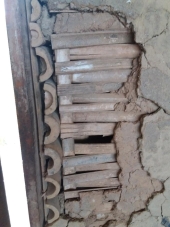Hi Matthew,
As far as quick goes... monsoon season is imminent. I can't really picture many options being quick enough to be ready for that. If one could get a timber frame constructed, it could be the basis for temporary tarp/tent based shelter now, and built into a full house later. Another possibility to consider is that resources could be concentrated on larger community buildings that would later serve as schools or clinics etc, which could provide temporary shelter until houses can be rebuilt.
For longer term options, not being at all familiar with Nepalese architecture, I went looking for some basic info and found this recent article:
http://www.philly.com/philly/opinion/20150503_How_to_rebuild_a_safer_Nepal_.html
It claims that 80% of Kathmandu is modern-ish structures of reinforced concrete or masonry/concrete, which mostly survived albeit with damage. It further states that the other 20%, and the vast majority of the rural villages, are unfired mud-brick or stone, with clay mortar. This is the construction that fared extremely poorly in the quake. The article also mentions how it differs from similar architecture in nearby regions. In short, it leaves out timber frames or runner beams; there is very little to tie the structure together.
I would think that training people to be able to build the same sort of structure with a real timber frame might be easier than proposing an entirely different building method. Expertise and information should hopefully be available from nearby countries. For urban areas where 3+ story buildings are crammed together, it seems like the most realistic option.
I also found this site interesting; this group is developing, building, and advocating for bamboo and adobe buildings as an earthquake resistant option for Nepal. Wasn't able to find any information about how their buildings fared in the quake.
http://abari.org/
If a completely different approach is preferred, my understanding is that rammed earth and earthbag construction both offer good earthquake resistance.
It looks like at least one earthbag building survived the quake:
http://www.3news.co.nz/world/earth-bag-building-still-standing-after-nepal-quake-2015050316#axzz3ZBbVYF8G
It was on the far side of Kathmandu from the epicenter, but still in the high damage zone; according to the article, '90% of the area is flattened'. It looks to be using straight walls and no obvious reinforcement in corners etc; earthbag construction could certainly be built stronger than this example if desired.
As far as water purification goes, with monsoon around the corner perhaps rainwater collection for drinking water is a good short-term option?







